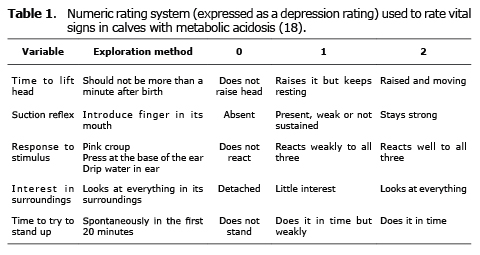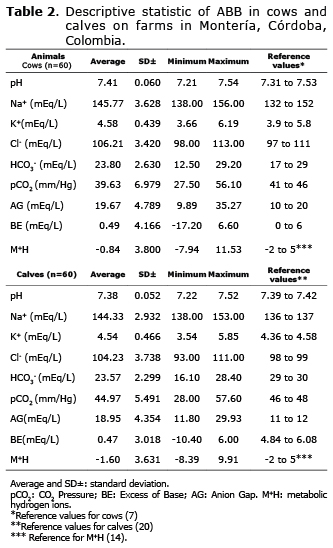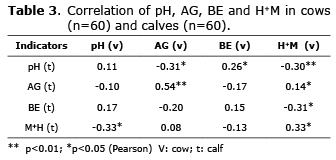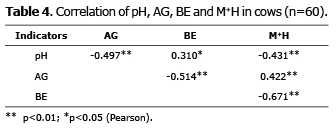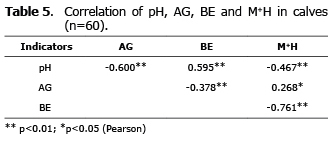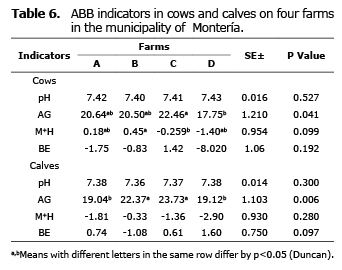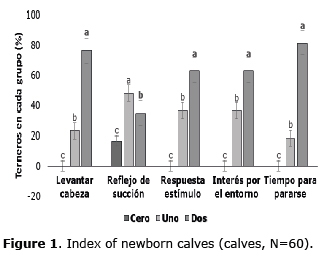Serviços Personalizados
Journal
Artigo
Indicadores
-
 Citado por SciELO
Citado por SciELO -
 Acessos
Acessos
Links relacionados
-
 Citado por Google
Citado por Google -
 Similares em
SciELO
Similares em
SciELO -
 Similares em Google
Similares em Google
Compartilhar
Revista MVZ Córdoba
versão impressa ISSN 0122-0268
Rev.MVZ Cordoba vol.20 no.2 Córdoba maio/ago. 2015
ORIGINAL
Physiology of acid-base balance in bovines with diarrhea backgrounds from Monteria, Colombia
Fisiología del estado ácido-básico en bovinos con antecedentes diarreicos de Montería, Colombia
César Betancur H,1* M.Sc, Yordan Martínez A,2 Ph.D, Luis Cruz M,3 Esp.
1Universidad de Córdoba, Facultad de Medicina Veterinaria y Zootecnia. Departamento de Ciencias Pecuarias. Montería, Colombia.
2Universidad de Granma, Facultad de Medicina Veterinaria. Centro de Estudios de Producción Animal. Bayamo, Granma. Cuba.
3Universidad Nacional de Colombia, Facultad de Medicina, Unidad de Fisiología. Bogotá, Colombia.
*Correspondence: betanci@yahoo.com
Received: April 2014; Accepted: January 2015.
ABSTRACT
Objective. Evaluate the acid-base balance (ABB) in bovines with diarrheic backgrounds in four areas of Montería, Colombia. Materials and methods. From a total of 300 pregnant cows, 60 were selected with their newborns. A direct inspection was performed of vital signs on the calves and the ABB indicators were determined using a gasometric method. Data were processed by means of descriptive statistics and the Duncan test was used to differentiate between the averages. The degree of association was established between the ABB indicators in cows and calves by using the Pearson correlation and a comparison of proportions was performed on the indexes of the newborns. Results. Regarding the cows, the ABB indicators were found within the reference values; however, in the calves the pH, pCO2, HCO3-, the anion gap (AG) and the bases excess (BE) varied. A correlation was found between AG, BE and metabolic hydrogen ions (M*H). The AG in cows and calves showed notable differences (p<0.05) among the farms in the study. According to the numeric classification system, the suction reflect indicated a greater percentage of calves in group one. Conclusions. The ABB analyte measurement in cows was similar to the consulted reference; however, in calves some analytes did not coincide. This suggests metabolic acidosis in newborn calves due to the increase of AG and the decrease of BE. Additionally, its correlation with M*H opens the possibility of new proposals to determine ABB in bovines. .
Key words: Metabolic acidosis, anions, diarrhea, metabolic hydrogen ions (Source: CAB).
RESUMEN
Objetivo. Evaluar el equilibrio ácido-básico (EAB) en bovinos con antecedentes diarreicos de cuatro zonas de Montería, Colombia. Materiales y métodos. De un total de 300 vacas preñadas se seleccionaron 60 vacas y sus recién nacidos. Se realizó una inspección directa de los signos vitales en terneros y los indicadores del EAB se determinaron mediante técnica gasométrica. Los datos se procesaron mediante estadística descriptiva y para la diferencia entre medias se empleó la prueba de Duncan. El grado de asociación se estableció entre los indicadores del EAB en vacas y terneros mediante la correlación de Pearson y una comparación de proporciones se realizó en los índices del recién nacido. Resultados. En las vacas, los indicadores del EAB se encontraron dentro de los valores de referencia; sin embargo, en los terneros varió el pH, pCO2, HCO3-, la brecha aniónica (AG) y el exceso de bases (EB). Se encontró correlación entre AG, EB e hidrogeniones metabólicos (H+M). El AG en vacas y terneros indicó diferencias notables (p<0.05) entre las fincas de estudio. De acuerdo con el sistema de calificación numérica, el signo reflejo de succión indicó el mayor porcentaje de terneros en el grupo uno. Conclusiones. La medición de los analitos del EAB en vacas fue similar a la referencia consultada; sin embargo, en terneros no coincidió con algunos analitos. Se sugiere acidosis metabólica en los terneros recién nacidos por el aumento del AG y descenso del EB, además, su correlación con los H+M abre la posibilidad de nuevas propuestas para la determinación del EAB en bovinos.
Palabras clave:Acidosis metabólica, aniones, diarrea, hidrogeniones metabólicos (Fuente: CAB).
INTRODUCTION
Diverse alterations of acid-base balance (ABB) are found in bovines, among which metabolic acidosis is particularly frequent (1). The diarrheic syndrome is the most frequent cause of metabolic acidosis in calves, especially during the neonatal period (first 28 days of life) (2). The cause of neonatal diarrhea is multifactorial; the calves at birth are susceptible to being agammaglobulinemic, and therefore they tend to suffer specific or secondary infections unless they quickly ingest colostrum (3); but beyond the causes of diarrhea, a hydroelectrolytic imbalance develops that generally causes dehydration, acidosis, and frequently death (4).
The first physiological model to evaluate ABB was proposed in 1908 by Lawrence Henderson. This author worked on the concept of acid as a donator of protons and hydrogen ions (Arrhenius definition 1890), (5). In 1916, Hasselbalch converted the Henderson equation into a logarithmic expression, which describes this known equation as Henderson-Hasselbalch (HH); where the ABB is obtained from measuring the HCO-3/H2CO3 buffer pair (6).
The HH equation has been a valuable tool to help understand the physiology of the acid base balance and is used in the clinical management of ABB disorders in ruminants; this equation explains the pH changes due to the changes in the concentration of HCO-3 and the pressure values of CO2 (pCO2) (7).
For many years, the bicarbonate/carbonic acid system has been kept in mind to define the terms acidosis and alkalosis, using the total content of CO2 and bicarbonate as reference points to classify respiratory or metabolic alterations (8). However, the HH equation does not separate the respiratory component from the metabolic one.
In 1948, Singer and Hastings (9) proposed the concept of the buffer base (BB) from the concept of the electroneutrality of solutions and interpreting that anions behaves as acids; thus, in 1960 Anderssen et al (10) introduced the term Excess of Bases (BE) as an independent variable of the pCO2. The BE represents the metabolic component or change of non-volatile acids or bicarbonate, calculated under ideal conditions, that is, with a pCO2 of 40 mmHg; since then the BB and the BE were used to support the diagnosis of the metabolic component (11).
The concept of anionic gap or Anion Gap (AG) arose in the 1970s as a way to classify metabolic acidosis and explain its causes (12). The importance of the calculation is that it allows differentiating of metabolic acidosis into two main types: metabolic acidosis with elevated AG or normal AG, caused by a loss of bicarbonate (13).
Recently, Cruz et al (14) of the Physiology Unit of the Medical Faculty of the Universidad Nacional of Colombia proposed differentiating hydrogen ions (H+) that generate blood pH in metabolic H+ (M+H) and H+ derived from CO2 (H+-CO2). Due to this, the total hydrogen ions (Htot) are those that are derived from the pH value and that classically corresponds to the antilogarithm of the negative value of pH; then, knowing the slope of the relationship between pH and pCO2, the H+-CO2 (15) are obtained.
These latter approaches have been denominated as “semi-quantitative" and have an important place in clinical use, and would be taken as objective information. There are other parameters that are considered to be subjective information; those that could estimate the presence of acidosis in a newborn calf; the hypothesis that arises about the possibility of determining the ABB in a calf in field conditions, without recurring to the determination of blood gases.
In the studies consulted, there was not enough information found about assessing ABB during the establishment of enteric syndrome in bovines, and therefore the objective of this study was to determine the ABB in cow blood with diarrheic background, and their respective calves, at four farms in the department of Córdoba, Colombia, to establish if there are differences between those indicators in the farms studied, and evaluate if there is a correlation between the classically diagnosed ABB based on the HH equation, the BE, alterations in AG and with a new proposal for M+H, as well as analyzing the indexes of the newborn.
MATERIALS AND METHODS
Type of study. A prospective cross-sectional study was done.
Study site. The work was done in the municipality of Montería, department of Córdoba, located at 8°45' north and 75°53' west; the average temperature was between 28 and 35°C, 85% relative humidity, with an annual precipitation of 1.200 to 1.500 mm, and an altitude of 18 meters above sea level. The municipal area is 3.043 km2, with 27 divisions. Its northern border is Puerto Escondido, San Pelayo and Cereté; the eastern, San Carlos and Planeta Rica; the southern, Tierralta and Valencia; and the western with the department of Antioquia and Canalete.
Study population. Animals from four farms located in the municipality of Montería were used, with a history of diarrheic symptoms frequent in calves. The sample was composed of 300 pregnant cows in good condition, which corresponded to 10% of the population of four farms (A=70; B=50; C=60 y D=120) from the region. The calves were born over a two month period of time, so the weather had no influence during that time period.
Sample size calculation. From a population of 300 cows, a sample of n size was selected to determine the following formula:
 with
with 
Where Z corresponds to the percentile of the normal distribution that will be tested at 90, 91, 92, 93, 94 and 95%. P corresponds to the proportion, in this case unknown, of animals with a certain trend, which was considered as being equal to 0.5 given that it provides a greater sample size. E, is the maximum possible error that would be tested at levels 1, 2, 3, 4, 5, 6, 7, 8, 9 and 10. N=300. According to data reported by the Colombian Cattle Federation (FEDEGAN), in 2007 the bovine population in the municipality of Montería was 178.320 females older than two years (16); this was considered n.
The bovines in these areas are mostly composed of Zebu crossbred with European breeds, mixed: Zebu x Holstein and Brown Swiss.
To determine the size of the sample, a normal distribution table was used, with a statistical reliability rate of 94% and with a maximum allowed error rate of 5%, and the size of the final sample was 60 animals. Sixty pregnant cows and their respective offsprings were evaluated in the four farms that were selected.
Taking and processing the sample. After disinfecting the area and subjecting the animal adequately, 5 ml of blood was obtained from the umbilical vein of the calves after birth without allowing them to suck colostrum and in the coccygeal vein of the cows. The procedure was done with commercial heparinized syringes (200 µl of sodium heparin), bending the needle to avoid forming bubbles, and the samples were held on ice and were analyzed within two hours. The identifying data were recorded on individual medical record sheet. The presence of diarrhea syndrome was observed between 8-12 hours after birth. To perform the procedures described above, the regulations contained in bill 84 of 1989 related to animal welfare were observed (17).
A direct inspection was performed of vital signs on calves using the table 1 (18) as well as the laboratory variables needed to perform ABB calculations by means of an ionogram and the gasometric method.
A Rapidlab 348 (Bayer Lab. Germany) apparatus was used for blood gases, which works with selective direct ion electrodes and measuring bands for the results of pCO2, Na+-, K+, Cl- and pH. Bicarbonate calculation and BE were determined in an automated way by means of gas equipment.
The AG was calculated using the formula (Na+ + K+) - (Cl- + HCO3-) (13) and the metabolic hydrogen ions (M+H) as total hydrogen ions (Htot) minus the H+ derived from the CO2 (H+-CO2). M+H values greater than +5 mmol/L correspond to a metabolic acidosis and a value less than -2 mmol/L to a metabolic alkalosis (14).
The samples were processed at the Zairo Laboratory of the Zayma Clinic in Montería, Colombia.
Statistical analysis. Data were processed using descriptive statistics, and the arithmetic mean and standard deviation were determined for each of the measured indicators. The Duncan test for the multiple comparisons of means was used when necessary. In addition, a Pearson correlation was developed to establish the degree of association between pH, AG, BE and M+H in calves, cows and both. Also, the indexes of the newborn were determined by comparing proportions. Statistical software SPSS, version 16, was used (19).
RESULTS
Descriptive statistics of ABB in cows and calves. In table 2 the medium, minimum and maximum values are observed of the ABB in cows with diarrheic backgraunds and calves, as well as a comparison with reference values. In cows only the pCO2 (39.63 mm/Hg) diminished in comparison with the reference values (7) (Table 2). On the other hand, in calves the concentration of electrolytes Na+ (144.33 mEq/L) and Cl- (104.23 mEq/L) and AG (18.95 mEq/L) increased in comparison with the reference values (20); nevertheless, in these animals a reduction of pH (7.38), HCO-3 (23.57 mEq/L), pCO2 (44.97 mm/Hg) and BE (0.47 mEq/L) was found.
Correlation of pH, AG, BE and M+H in cows and calves. Table 3 shows the comparison with ABB in calves and cows. The pH (t) had a positive correlation with BE (v) (p<0.05) and a negative correlation with AG (v) (p<0.05) and the M+H (v) (p<0.01). Also, the AG (t) affected a positive correlation with AG (v) (p<0.01) and M+H (v) (p<0.05). Additionally, a negative correlation between BE (t) and with M+H (v) (p<0.05) was observed. In the same way M+H (t) indicated a negative and positive correlation with reference to pH (v) (p<0.05) and M+H (v) (p<0.05). The finding of a high correlation between the cows with their respective newborns for AG (0.54**) was noteworthy.
Tables 4 and 5 indicate the correlations between the ABB in cows and calves separately. All the correlated indicators showed significant differences (p<0.05) and the same correlational tendencies.
The pH indicated negative correlations with AG (p<0.05) and M+H (p<0.01) and positive with BE (p<0.05). However, AG showed a negative correlation with BE (p<0.01) and a positive one for M+H (p<0.05; p<0.01). Also, a negative correlation was observed for the BE and M+H indicators (p<0.01) (Tables 4 and 5).
ABB indicators in cows and calves at four farms in the municipality of Montería. The pH and BE in cows and calves and M+H in calves did not show significant differences (p>0.05) between the farms in the study; nevertheless, AG (cow) increased in Farm C and showed statistical differences (p<0.05) with Farm D. In cows, M+H indicated significant differences (p<0.05) for Farms B and C. On the other hand, in calves, AG showed notable differences (p<0.05) between the same farms with relation to Farms A and D (Table 6). It is noteworthy that AG showed significant differences in cows and calves in the same areas of the study.
Indexes of the newborn. The proportion of calves in each index according to the subjective results is observed in figure 1. Signs such as raising the head, responding to stimulus, interest in the environment and time to get into station are shown in greater proportions (p<0.05) in rating group two, according to the numeric rating system (Table 1), on the opposite of the suction reflex (p<0.05), which showed significant values in rating group one. It is noteworthy that except for the suction reflex sign, other indexes did not indicate animals (calves) in group zero.
DISCUSSION
The results obtained showed that the ABB indicators were generally within the physiological reference values according to the literature consulted (7,14,20); however, in calves the following analytes did not match: pH, pCO2, HCO-3, AG, and BE.
The increase of plasmatic Na+ can be explained by a raise in the level of aldosterone at birth, Cl- follows Na+; these results are similar to those reported by Herosimczyk et al (21).
In calves, the decrease of pH, pCO2 and HCO-3 (Table 2) suggests a condition of metabolic acidosis, which agrees with that obtained by Lisboa et al (22) in newborn animals; the low pH stimulates the increase of ventilation which involves a decrease of pCO2.
The increase of AG and the reduction of the BE (Table 2) in some calves could indicate a possible metabolic acidosis; this condition is caused, among other reasons, by diarrhea, which causes alterations in the hemogasometric parameters such as the decrease of serum bicarbonate, BE and increases AG; these results are similar to those obtained by Freitas (20).
If this state is maintained, the calves would enter a state of serious metabolic acidosis, which would mean death for most of the animals due to metabolic alterations. In Farm B there were two calves that died from diarrhea, with low concentrations of pH and BE (data not shown).
On the other hand, a direct relationship with the AG value was found between cows and their respective newborns (Table 3). At the time of birth the fetus suffered metabolic acidosis as a consequence of suspending the umbilical flow of blood, the effort made during birth established an anaerobic metabolic process, at least until the beginning of respiratory functions (3).
The correlations in cows and calves between pH with AG, BE and M+H (Tables 4 and 5) is important, since it allows using any technique to identify ABB in bovines, differentiate and rate metabolic acidosis with AG and M+H, and BE is a fundamental indicator to diagnose and establish corrective therapies in ABB (23).
The significant differences (p<0.05) in AG in calves and cows between Farms B and C regarding Farms A and D (Table 6) can be explained due to the geographic location, since Farms B and C are found in areas that are prone to flooding, which can predispose the appearance of acidosis, given that flooding causes anoxia, which provokes the formation of volatile sulphuric acid (24); on the other hand, flooding can facilitate the presence of infectious diseases.
The correlation between the different variables (pH, BE, AG) with M+H is important from a practical point of view, since only by determining the pH and the pCO2 can the ABB be evaluated (25); also, it opens the way to use M+H as part of the ABB diagnosis in bovines in field conditions where analytical tools are not available.
Metabolic acidosis causes clinical symptoms that are attributable to a neurological dysfunction (26). Diarrhea is the most important and frequent cause of metabolic acidosis in calves and one of the principal neurological changes in an acidotic calf is the loss of the suction reflex (27). In this sense, studies have been done to indicate the association between systemic acidosis with the deterioration of the suction reflex (28) and between BE with changes in attitude and behavior (29) as well as the relationship between dehydration and the posture of the animal (30). Therefore, these vital signs of the newborn could be used as clinical physiological indicators of newborn acidosis in bovines.
It is concluded that in the studied population, ABB analyte measurements in bovines were similar to the reference consulted and could be used as a reference for future studies. Metabolic acidosis is suggested in calves keeping in mind the values of AG and BE and with M+H; this last variable that rates the metabolic component of ABB is evaluated for the first time in bovines. When evaluating the indexes of the newborn in bovines by means of vital signs, opens the possibility of using them in a predictive way, especially the suction reflex, in order to prevent the newborn acidosis in calves under field conditions without recurring to a hemogasometric determination.
Acknowledgements
To the research and extension office of the Universidad de Córdoba, Colombia. FMV-05-06.
REFERENCES
1. Cho YI1, Yoon KJ. An overview of calf diarrhea - infectious etiology, diagnosis, and intervention. J Vet Sci 2014;15(1):1-17. [ Links ]
2. Lorenz I, Fagan J, More SJ. Calf health from birth to weaning. II. Management of diarrhea in pre-weaned calves. Ir Vet J 2011; 64(1):1-6. [ Links ]
3. Murray CF, Leslie KE. Newborn calf vitality: risk factors, characteristics, assessment, resulting outcomes and strategies for improvement. Vet J 2013; 198(2):322-328. [ Links ]
4. Baquero-Parrado JR. Diarrea neonatal indiferenciada en terneros: consideraciones sobre su prevención en campo. Vet Zoo Tec 2008; 2(2):59-68. [ Links ]
5. Carrillo R, Visoso P. Equilibrio ácido-base. Conceptos actuales. Rev Asoc Mex Med Crit y Ter Int 2006; 20(4):184-192 [ Links ]
6. Hasselbalch KA. Die Berechnung der wasserstoltzahl des blutes ous der freien und gebunden kohlensaure desselben, und die sauerstoltbindung des blutes als function der wassertozahl. Biochem Z 1917; 78:112-144. [ Links ]
7. Kaneko J, Harvey JW, Bruss ML. Clinical biochemistry of domestic animals. 6a ed. Amsterdam: Elsevier Inc; 2008. [ Links ]
8. Oetzel GR. Monitoring and testing dairy herds for metabolic disease. Vet. Clin. North Am., Food Anim Pract 2004; 20(3):651-674. [ Links ]
9. Singer RB. Haslings AB. An improved clinic method for the estimation of disturbances of the acid-base balance of human blood. Medicine (Baltimore) 1948; 27(2):223-242. [ Links ]
10. Andersen OS, Engel K, Jorgensen K, Astrup P. A micro method for determination of pH, carbon dioxide tension, base excess and standard bicarbonate in capillary blood. Scand J Clin Lab Invest 1960; 12:172-176. [ Links ]
11. Bookallil MJ. pH of the blood: acid base balance. [en línea]. University of Sydney. 2010. (acceso septiembre de 2013); URL disponible en: http://www.anaesthesia.med.usyd.edu.au/resources/lectures/acidbase_mjb/acidbase.html. [ Links ]
12. Emmelt M. Narins RG. CIinical use of the Anión Gap. Medicine (Baltimore) 1977; 56(1):38-54. [ Links ]
13. Radostits OM, Gay CC, Hinchcliff KW. Veterinary Medicine. A textbook of the diseases of cattle, horses, sheep, pigs, and goats. 10th ed. Philadelphia: Elsevier Inc; 2007. [ Links ]
14. Cruz LE, Diaztagle JJ, Giraldo E, Melo CE, Sprockel JJ. Comparación de diferentes medidas para el abordaje fisiológico del estado ácido-base en pacientes críticos: papel de los hidrogeniones metabólicos. Acta Colombiana de Cuidado Intensivo 2009; 9(2):131-144. [ Links ]
15. Kraut JA, Madias NE. Metabolic acidosis: pathophisiology, diagnosis and management. Nat Rev Nephrol 2010; 6:274-285. doi:10.1038/nrneph.2010.33 [ Links ]
16. Resolución 002341. [en linea]. Bogotá, Colombia: ICA-FEDEGAN. Instituto Colombiano Agropecuario; 2007. URL Disponible en: http://www.slideshare.net/Fedegan/resolucion-2341. [ Links ]
17. Mrad de Osorio A. ética en la investigación con modelos animales experimentales. Revista Colombiana de Bioética 2006; 1(1):163-184. [ Links ]
18. Kasari TR, Naylor JM. Further studies on the clinical features and clinicopathological findings of a syndrome of metabolic acidosis with minimal dehydration in neonatal calves. Can J Vet Res 1986; 50(4):502-508. [ Links ]
19. SPSS Inc. SPSS for Windows Version 16.0. Chicago, Illinois, USA: SPSS Inc; 2007.
20. Freitas, MD. Avaliação dos parâmetros clínicos e de patologia clínica em bezerros naturalmente infectados com diarréia neonatal. [Dissertação Mestrado em Medicina Veterinária]. Brasil: Universidade Federal de Minas Gerais, Escola de Veterinária; 2009. URL Disponible en: http://www.bibliotecadigital.ufmg.br/dspace/handle/1843/SSLA-83KKES. [ Links ]
21. Herosimczyk A, Lepczynski A, Dratwa-Chalupnik A, Kurpinska A, Klonowska A, Skrzypczak WF. Age-related changes of selected blood biochemical indicators in dairy calves during their first week of life. Folia Biol (Krakow) 2011; 59(1-2):25-30. [ Links ]
22. Lisboa JAN, Benesi FJ, Leal MLR, Teixeira CMC.Leal. Efeito da idade sobre o equilibrio ácido básico de bezerras sadias no primeiro mes de vida. Braz J Vet Res Anim Sci 2002; 39(3):136-142. [ Links ]
23. Kirchner D, Schwedhelm L, Coenen M, Bachmann L. Dietary influences on the hydration and acid-base status of experimentally dehydrated dairy calves. Vet J 2014; 199(2):251-257. [ Links ]
24. Poot A, Gillissen F, Koelmans A. Effects of flow regime and flooding on heavy metal availability in sediment and soil of a dynamic river system. Environ Pollut 2007; 148(3):779-787. doi:10.1016/j.envpol.2007.01.045 [ Links ]
25. Effros RM. Stewart approach is not always a practical clinical tool. Anaesth Analg 2004; 98(1):271-272. [ Links ]
26. Nakagawa, M, Suzuki K, Taguchi K. Relationship between depression score and acid-base status in Japanese black calves with diarrhea. J Vet Med Sci 2007; 69(5):549-552. [ Links ]
27. Sobiech P, Rękawek W, Ali M, et al. Changes in blood acid-base balance parameters and coagulation profile during diarrhea in calves. Pol J Vet Sci 2013; 16(3):543-549. [ Links ]
28. Gentile A, Lorenz I, Sconza S, Klee W. Experimentally induced systemic hyperchloremic acidosis in calves. J Vet Intern Med 2008; 22(1):190-195. [ Links ]
29. Gómez De, Lofstedt J, Stämpfli HR, Wichtel M, Muirhead T, McClure JT. Contribution of unmeasured anions to acid-base disorders and its association with altered demeanor in 264 calves with neonatal diarrea. J Vet Intern Med 2013; 27(6):1604-1612. [ Links ]
30. Temiz M, Altuğ N, Yüksek N. Relationship between degree of anemia and blood gases in cattle with theileriosis. Turk J Vet Anim Sci 2014; 38:82-87. [ Links ]













